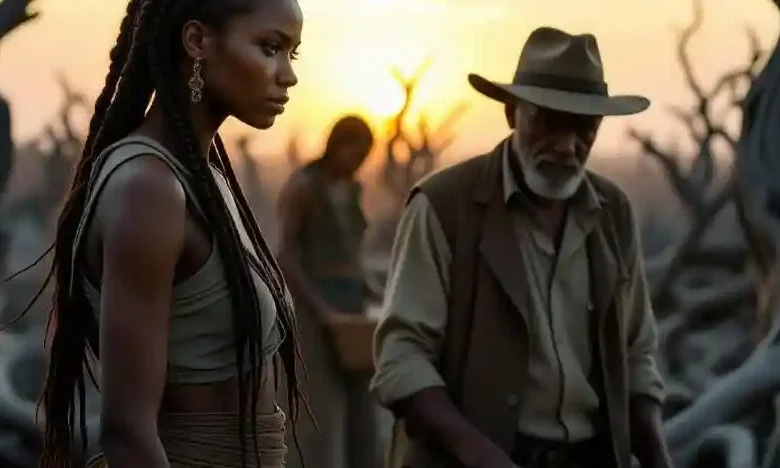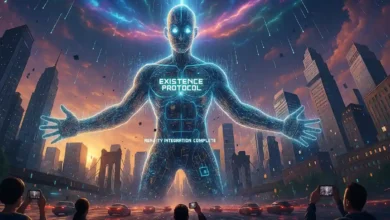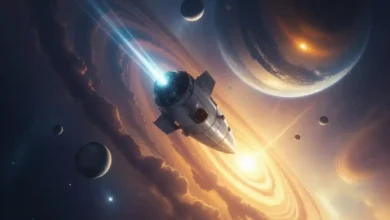Greenland 2 And The Post-Apocalyptic Survival Tech That Could Save Us

In a cinematic landscape dominated by explosive spectacle and last-second heroics, the newly dropped trailer for Greenland 2: Migration (releasing January 9, 2026) dares to do the unthinkable: it lingers in the ashes. Forget the frantic evacuations and fiery impacts of the original 2020 hit Greenland – this sequel thrusts us five years forward, into a shattered Post-Apocalyptic world where Gerard Butler’s John Garrity and his family claw their way out of a bunker, not just to survive the end, but to rebuild amid the ruins. What makes this trailer so electrifying? It’s a gritty portrait of humanity’s unyielding spirit in the aftermath – a phase Hollywood disaster flicks rarely explore, let alone sequel-ize. As the screen fades to black on visions of frozen wastelands and makeshift camps, one can’t help but wonder: In our own fragile reality, could we pull off the same feat? Do underground bunkers and bleeding-edge tech give us a fighting chance against cosmic doomsdays, or are we just scripting our own extinction event?
If you’re a fan of edge-of-your-seat thrillers laced with existential dread, buckle up. This deep-dive unpacks the trailer’s bold narrative shift, contrasts it with Hollywood’s aversion to post-apocalyptic sequels, and bridges the gap to real-world survival strategies. From billionaire bolt-holes to AI-powered water harvesters, we’ll explore whether humanity’s toolkit is apocalypse-ready – or if Greenland 2 is just wishful fiction. Let’s migrate into the unknown.
Why Hollywood Shies Away from Post-Apocalyptic Disaster Sequels: A Genre Autopsy
Disaster movies are the ultimate adrenaline rush: towering tsunamis in The Day After Tomorrow, rogue asteroids in Armageddon, or viral pandemics in Contagion. They thrive on the buildup – the panic, the peril, the narrow escape – but once the credits roll, the world is either saved or spectacularly doomed. Rarely do studios greenlight sequels that dwell in the “Day After,” opting instead for reboots or unrelated franchises. Why? It’s a high-risk gamble. Post-apocalyptic tales demand nuance: not just action, but the slow-burn tedium of rationing canned beans and forging alliances in irradiated badlands. Box-office gold like Independence Day: Resurgence (2016) tried, blending alien invasions with reconstruction, but it flopped critically, highlighting audiences’ preference for fresh threats over lingering fallout.
Consider the stats: Of Rotten Tomatoes’ ranked list of 50 disaster films, fewer than 10% feature true post-apoc sequels. The Road Warrior (1981) extended Mad Max into wasteland wanderings, but that’s more action saga than pure disaster. World War Z (2013) teased zombie aftermaths in its sequel plans, yet pivoted to prequels. Even climate epics like Geostorm (2017) end with restored order, avoiding the messy rebuild. This aversion stems from narrative fatigue – why sequel a story where the heroics are over? – and production woes: Building practical sets for ruined cities costs a fortune, and CGI fatigue sets in fast.
Enter Greenland 2: Migration, a beacon in this barren genre. By committing to the “what now?” phase, it flips the script, inviting us to ponder not just survival’s thrill, but its toll. As Morena Baccarin (Allison Garrity) told Collider, the film’s heart lies in “the story of this family that really is trying to survive… that’s why it got a sequel.” It’s a rare sequel that doesn’t reset the board – it shuffles the ruins.
Unpacking the Greenland 2: Migration Trailer: Humanity’s Raw Resilience Revealed
Dropped on September 25, 2025, the two-minute trailer for Greenland 2: Migration – directed by Ric Roman Waugh and starring Butler, Baccarin, Roman Griffin Davis as son Nathan, and newcomer Amber Rose Revah as Dr. Casey Amina – opens not with a bang, but a creak. The Garrity family, last seen racing to bunkers as comet Clarke fragmented Earth in the 2020 original, emerges from their underground sanctuary into a world remade by catastrophe. Snow-swept vistas hide crumbling skyscrapers; nomadic tribes scavenge under aurora-like skies warped by atmospheric debris. “The end of the world was just the beginning,” intones a gravelly voiceover, as John Garrity barters with survivors, fends off raiders, and leads a migration toward rumored safe havens.
Key plot beats pulse with urgency: The family joins a ragtag convoy, navigating frozen tundras on jury-rigged vehicles, while flashbacks tease the bunker’s claustrophobic horrors – flickering lights, ration fights, and the gnawing doubt of re-entry. Revah’s Dr. Amina, a scientist with bunker intel, hints at broader stakes: rogue fragments still orbit, and society’s remnants fracture into factions. Action erupts in visceral bursts – a bridge collapse mid-escape, hand-to-hand skirmishes over fuel – but the trailer’s genius lies in quiet moments: A father-son stargazing session under polluted heavens, Allison bandaging wounds by firelight, whispers of “We made it… now what?”
This isn’t zombie hordes or mutant chases; it’s humanity unfiltered. The trailer spotlights resilience’s double edge: ingenuity in hydroponic greenhouse hacks (nodding to bunker tech), but also despair’s shadow – orphaned kids, irradiated wildlife, moral quandaries over mercy kills. Baccarin described filming as “a blur of exhaustion and running and crying,” mirroring the characters’ plight. Producer Sébastien Raybaud even teased a potential Greenland 3 to Deadline, hinting at “tricky” twists that could escalate the rebuild. In theaters January 9, 2026, this sequel doesn’t just extend the franchise – it humanizes the apocalypse, making us root not for spectacle, but for scarred souls pressing on.
From Silver Screen to Subterranean Reality: Echoes of Greenland in Our World
Greenland‘s comet swarm isn’t pure sci-fi; it’s ripped from NASA’s playbook. Real asteroids like Apophis (due for a 2029 close shave) or the 2013 Chelyabinsk meteor remind us: Space rocks strike without warning, unleashing firestorms, tsunamis, and “impact winters” that could plunge Earth into famine for years. The trailer’s bunker emergence? It mirrors doomsday preppers’ wet dreams – and billionaires’ investments. But does fiction’s grit hold up against fact? Let’s drill down.
Underground Bunkers: Fiction’s Fortresses, Reality’s Last Resorts
In Greenland 2, the Garritys’ bunker is a lifeline turned pressure cooker, sustaining them through dust-choked skies. Cut to reality: Humanity’s already burrowed deep. The U.S. military’s Cheyenne Mountain Complex in Colorado – a Cold War relic carved into granite – withstands nuclear blasts with 2,000-foot-thick walls and self-sustaining air filtration. It’s operational today, monitoring threats via NORAD.
For civilians, luxury doomsday dens abound. Kansas’ Survival Condo Project, a converted missile silo, fetches $3 million per unit: 5,000 sq ft of blast-proof luxury with pools, theaters, and aquaponic farms churning out tilapia and veggies. Atlas Survival Shelters in Texas builds NBC (nuclear, biological, chemical) filtered homes starting at $40,000, buried under backyards. Europe’s Vivos xPoint in South Dakota houses 5,000 WWII-era bunkers for $25,000 each, expandable into self-contained villages.
Billionaires up the ante: Mark Zuckerberg’s $270 million Hawaii compound includes a 5,000 sq ft underground shelter with blast doors and food stores. New Zealand’s “billionaire belt” – think Peter Thiel’s properties – features fortified estates. And don’t forget The Oppidum in Czechia, a $50 million mega-bunk: 323,000 sq ft with spas, wine cellars, and panic rooms. These aren’t just holes in the ground; they’re ecosystems, powered by geothermal wells and stocked for decades. Yet, as Greenland 2 implies, isolation breeds madness – real psych studies on Antarctic bases show cabin fever spikes after months underground.
Post-Apocalyptic Tech Arsenal: What We’ve Got (and What We Need)
The trailer’s makeshift migrations scream resourcefulness, but humanity’s tech edge could turn fiction feasible. Atmospheric water generators, like Watergen’s units, pull 5,000 liters daily from humid air – vital in dust-veiled worlds. Hydroponics and vertical farms, scaled in Singapore’s Sky Greens, yield 10x traditional crops sans soil, perfect for bunker basements.
Energy? Small modular reactors (SMRs) from NuScale Power deliver 77 MW cleanly, fueling off-grid outposts without fossil fuels. For mobility, electric ATVs with solar-rechargeable batteries (think Rivian’s R1T) outlast gas guzzlers in fuel-scarce hellscapes. Medical tech shines too: CRISPR gene editing combats radiation-induced cancers, while portable dialysis units from Outset Medical sustain kidneys sans hospitals.
Even AI steps up: Douglas Rushkoff’s “apocalypse-proof programming” embeds survival algorithms in rugged devices, guiding crop rotation or water purification. A “Portable Civilization Starter Kit” – solar panels, offline GPT models, 3D printers – could bootstrap tech trees, printing tools from scavenged plastic. Lewis Dartnell’s The Knowledge outlines “bounce-back” blueprints: Forge steel from clay, distill ethanol fuel, breed hardy livestock. We’ve got the seeds – literally, in Norway’s Svalbard Global Seed Vault, safeguarding 1 million crop varieties against Armageddon.
But gaps gape: Scaling these for billions? Unlikely. Most tech favors the elite; Vivos’ $300 million Aerie bunker boasts robotic surgeons and AI concierges, but at what equity cost?
Do We Even Have a Shot? A Sobering Reality Check on Apocalypse Odds
Greenland 2‘s trailer isn’t escapism – it’s a mirror. It provokes: In a real comet cascade, would family bonds hold, or fracture under scarcity? History nods yes – post-WWII Europe’s “rubble women” rebuilt from blitzkriegs, while Chernobyl’s liquidators contained fallout through sheer will. Yet, scale matters: A 10km impactor (Clarke-sized) could trigger global winter, slashing crops 90% and sparking wars over the scraps.
Our chance? Guarded optimism. Bunkers buy time – months for elites, weeks for masses – but long-term, it’s adaptation or bust. Tech like geoengineering (stratospheric aerosols to cool Earth) or asteroid deflectors (NASA’s DART mission, 2022 success) could preempt disaster. Still, inequality looms: While Zuck hunkers down, the global south bears climate brunt first.
Ultimately, Greenland 2 reminds us survival isn’t solitary – it’s collective. As the Garritys trek onward, so must we: Invest in resilient grids, democratize bunkers, teach “bounce-back” skills. Or risk the trailer’s warning becoming prophecy.
What do you think – is Hollywood onto something profound, or just profiting off our fears? Drop your takes below, and stream the trailer now. In a world of fragile orbits, curiosity might be our best bunker yet.
For more Odinozz Spotlight articles, click here.
Follow Odinozz on social media. Click here.



